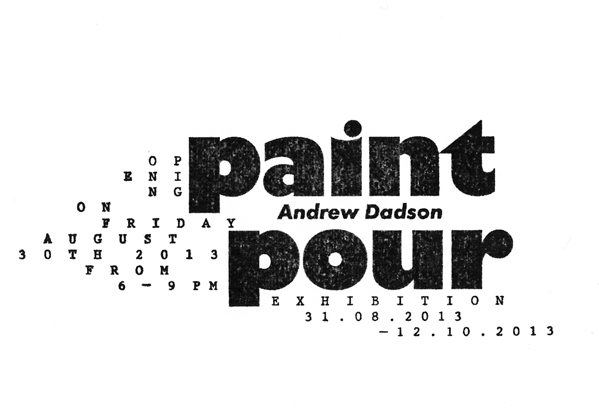verlängert bis zum 26. Oktober 2013
extended until October 26th 2013
Andrew Dadson
paint pour
31.08.13 – 26.10.13 | Opening August 30th 2013, 6 - 9 PM
PRESS RELEASE
Andrew Dadson. paint pour
August 31 – October 12, 2013
Pfingstweidstrasse 23 / Welti-Furrer Areal, 8005 Zürich
Opening reception: Friday August 30, 6 – 9 pm
RaebervonStenglin is proud to present paint pour, an exhibition of new work by Canadian artist Andrew Dadson. Pushing the parameters of painting, Dadson also tests his medium's physical and emotional limits. Paint is not only poured in his works, but scraped, spread, dripped, layered and erased as it hardens and cements, coats and obscures, changing whatever supports it in the process. Canvases are subjected to this treatment, re-stretched or solidified to the walls they lean against in an inversion of their traditional relationship; and so too are living objects: plants painted black and placed under a grow-lamp in the back gallery.
Dadson is best known for his direct interventions on landscape. His 'Lawn' and 'Yard' paintings transformed patches of outdoor space, with or without their owners' permissions, into monochrome squares with all objects therein — grass, shrubs, walls, fences and bric-a-brac — painstakingly black or whited out with plant-based paint. Such works articulate boundaries whilst changing over time. Dadson is interested in nature's ability to survive his assault; the way in which flowers and grass grow back through the black creating artworks of endless permutation and detail. Working in monochrome and in opposition to nature, Dadson's forebears stretch back to the decadent hero of J.K. Huysmans' notorious 1884 novel 'À Rebours' as well as to the artistic trajectory of Malevich, Fontana and Manzoni. Yet beneath their monochrome surfaces and at their edges, Dadson's works attest to plurality and the complexity of life.
Paint pour's title refers to the Glue Pour works Robert Smithson made directly onto land in Vancouver in 1969, a starting point for Dadson's interventions with paint on to plants. For the first time, Dadson is showing his painted vegetation in a gallery, planted directly into the gallery floor, and thus as sculpture rather than as photographic evidence. Nurtured with water and light, the plants will gradually grow through the black paint the artist has covered them in, ultimately eliminating his efforts. These will be shown in the company of his studio-based works in which oil paint flexes a muscular power, strong enough to leverage canvases from walls, expand edges and cement paintings in place. Showing the two aspects of Dadson's practice together, RaebervonStenglin lets the viewer consider his work across the breadth of its enquiry.

























